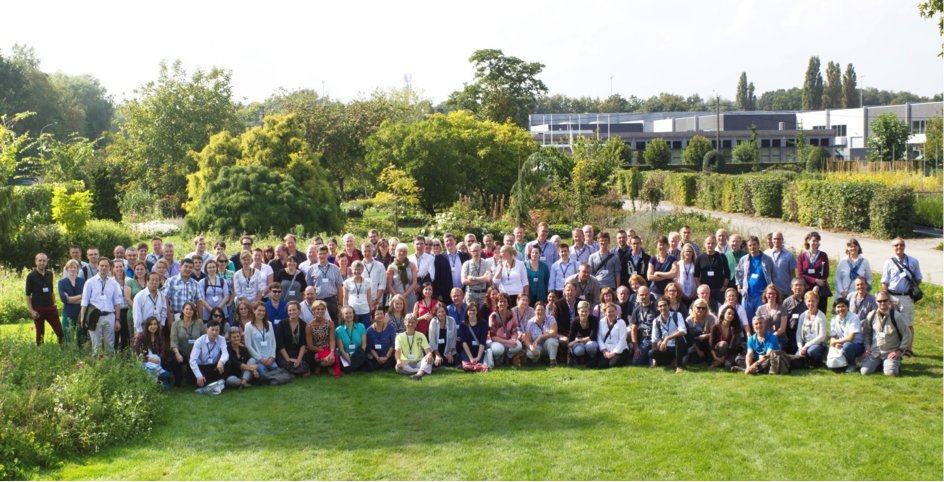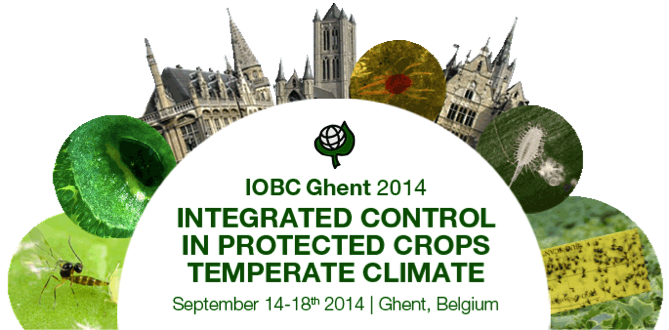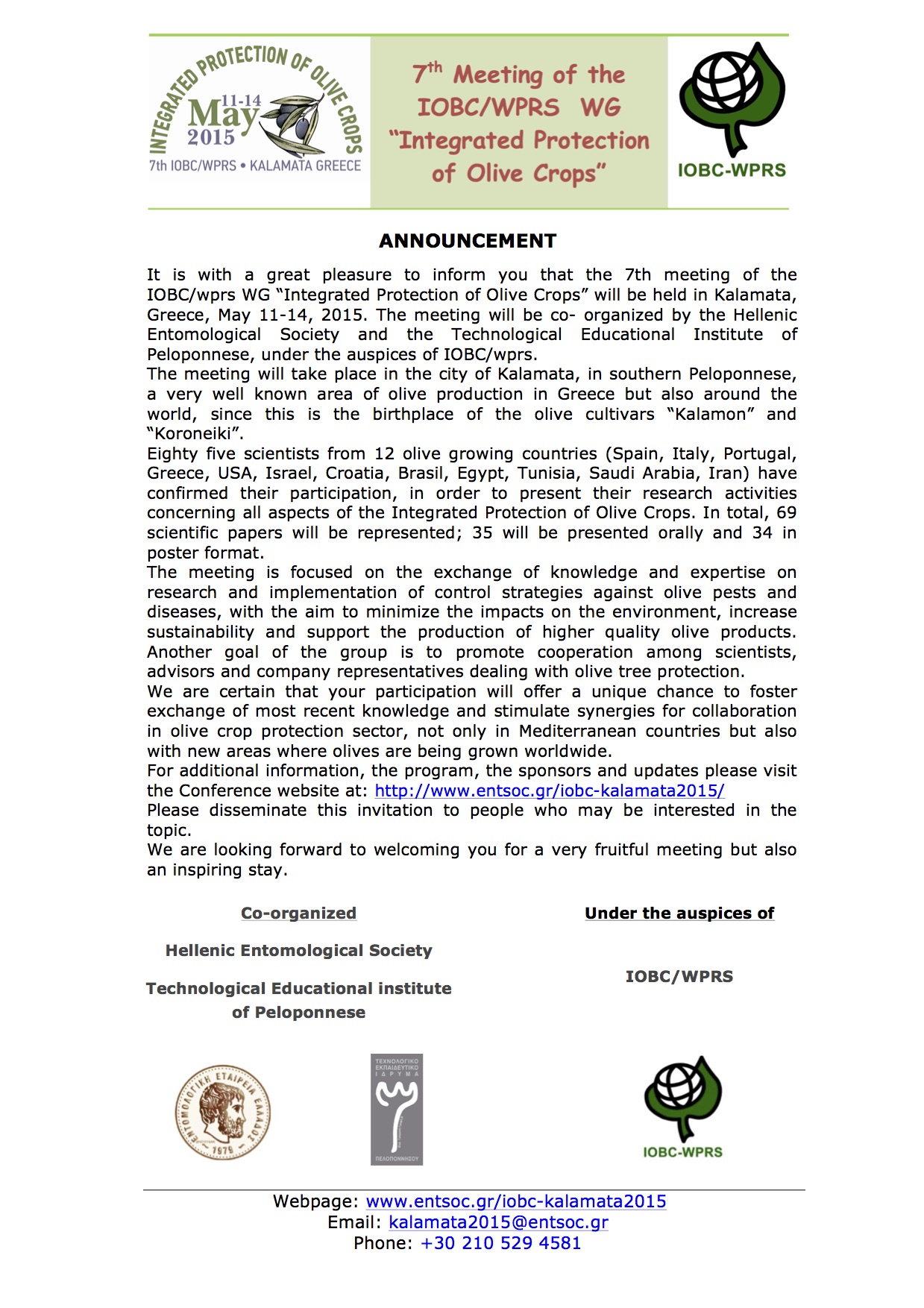|

The congress in a nutshell
During the meeting, talks were held on the most recent research developments in the field of biological and integrated crop protection. Here we will give a short summary of the most important conclusions and visions which were expressed during the meeting.
New and emerging pests and beneficials
The first session broached one of the major problems of crop protection, the new and emerging pests and how to tackle them. A major conclusion was that it will be more than ever important to have enough options for control. We can’t be dependent on only one or two predators or chemical products. For a good control, a combination of various beneficials and a number of chemicals will be crucial. The role of bio-pesticides (microorganisms like fungi, bacteria and nematodes) for the control of diseases and pests will also become more prevalent in the future of sustainable crop protection.
Another important thought was the fact that not only lethal effects on the pest should be researched, but sub lethal effects like reduced oviposition and slower population growth will also have an important contribution in pest control systems. Modern IPM programs will be dependent on a combination of different pest interfering processes, rather than one direct effect.
In terms of new control agents, the importance of local beneficials came forward. Beneficials which are naturally (genetically) adapted to certain regions and pests should be adopted in pest control systems. Moreover, the beneficials that enter the greenhouse naturally (e.g. parasitic wasps) are the cheapest type of pest control. Therefore it is important to be aware of their presence and take this into account when applying pest control measures and even try to make optimal use of their capacities.
Challenges for applying integrated pest management in practice
The session on integrated control in practice grasped the nettle and exposed the issues of practical application. Because of the reduced number of chemical products and the recently prolonged registration process for biological control agents, it will be vital to make optimal use of all possible control methods. All different control measures, e.g. resistant varieties, disinfection of tools, soil and water treatment, mass trapping, beneficials, chemical products, physical measures, …should be used in a way that they support each other and result in a stronger protection of the crop. Moreover, the whole production process should be taken into account, because factors like fertilization, substrate, water and climate all influence the activity of pests and beneficials. Growers and researchers alike should look upon the greenhouse as a single system, rather than a sum of independent processes.
Supplemental food for beneficials to sustain IPM
Supplemental foods to support beneficials are a much researched topic nowadays. This session gave a critical approach to the topic. The importance of practical experiments was emphasized. Results from lab experiments don’t always match those of (semi) field experiments, because in practice there are many more factors influencing the experiment as compared to lab tests.
On top of the food itself, the distribution of the food and climate in the crop is also an important issue in the development of the beneficial population. These factors determine the amount of energy needed to get to the food and thus the overall net energy profit, cost of searching versus benefit of eating.
Another main issue is the effect of supplemental food on the pest. This is something that should be taken seriously. Pollen for example is known to have a positive effect on thrips populations. Therefore researchers are focusing on artificial diets, which stimulate the beneficials, but have a minimal effect on the pest
Grower interaction: bringing science to the grower
On Tuesday afternoon, PCS – Ornamental Plant Research was host of the “Grower interaction session’. Together with the congress participants, there were an additional 60 participants from the Flemish greenhouse horticulture sector.
This session also emphasized that crop protection should be seen as an integrated part of the whole production system, where every decision will have an influence on different processes, including pest abundance. This is called the systems approach: ‘a system that is inherently resistant to many pests and thus requires fewer or no treatments with conventional pesticides’.
The interview with the ornamental grower Joris Volckaert and organic vegetable grower Krist Hamerlinck, confirmed this point. They both explained that working with beneficials should not be seen as an annoyance, it is a concept in which the grower needs to build up expertise. Using beneficials forces the grower, even more than before, to be aware of what is happening in the crop. Monitoring is the foundation for this approach and every decision should be taken consciously, keeping in mind the beneficial population, which should be supported as much as possible, while negative influences should be minimized. Because this is not always so obvious, it is important that the researchers and growers stay in close contact, where growers can be guided by researchers in the application of new techniques and strategies, but where researchers also get the necessary feedback from the practical level, to optimize their systems. To strengthen this connection between the growers and researchers, a barbecue with Belgian specialty beers was served to conclude the day.
Induced resistance: developing new tools for pest management
The session on induced resistance, took a look at crop protection from a different perspective. There are different ways to stimulate plants to activate their inherent protection system and thus protect themselves against pests and diseases. This is often done with ‘elicitors’, products that activate a certain (plant defense) response. These are often complex mechanisms, which require lots of research to fully understand and then influence this process in a way which contributes to a more sustainable and efficient crop protection. Promising results were shown on beneficials and fertilizers which induce a plant defense response. This is a topic with lots of promising research, which will give new possibilities for a sustainable crop protection.
In line with induced resistance, the topic of endosymbionts (organisms living inside another organism) was discussed. Among insects it is common knowledge that endosymbionts, usually bacteria, contribute to the build of important, often vital, nutrients. By influencing these endosymbionts, the viability of (pest) insects can also be influenced. This is a promising topic, but for now not yet fit for practical applications. In the coming years we expect that more will be discovered on this topic
Monitoring: the key to good integrated pest management
Monitoring brings us back to the basics of crop protection. Before you can solve a problem, you first have to identify it properly. It is important for the grower to establish his/her own thresholds, as these can differ between crops and greenhouses. They determine the moment when action is needed, not to risk financial losses. It is also important to scout regularly, to see the evolution of pests and beneficials in time. This way the result and efficiency of treatments can be evaluated and if necessary adjusted. A third conclusion that was made is the importance of efficient and focused scouting. Don’t waste time searching for things which are not important, but search efficiently for either important pests for the crop, or beneficials which may effectively contribute to the control of those pests.
A new evolution in monitoring is PCR-analysis, where genetic variations among pests and beneficials are evaluated. This is important because there are differences between pests and beneficials, which are not visible, but can influence the crop protection, e.g. not every whitefly strain is the same and sometimes different control measures are needed for the control of different types of whitefly. By performing genetical analysis, these differences can be charted and taken into account during the control process. For beneficials it is also important to know if there are genetical differences and to make efficient use of their strengths and weaknesses. This is a topic with lots of ongoing research, that will come into play more often in the near future.
Excursions
During the meeting, excursions were organized to different growers. There was a choice of ornamentals, vegetables & fruits and a mixed tour. The weather was great, which made the atmosphere all the better. The international audience started a nice discussion with the grower and asked questions to learn more about the similarities and differences between the Flemish horticulture and their local systems. The afternoon was concluded with a short tour of PCG – Vegetable Research, followed by a cozy walking dinner.
Intraguild predation: risks and benefits of combining beneficials
Using beneficials requires the full attention and dedication of the grower. If one works with more than one beneficial insect/mite, it also important to know how they influence each other. This is the specific research of intraguild predation, literally the battle between two or more predators for the same food. During these talks two topics came to the forefront.
First of all it is important to know if it is beneficial to introduce two predators at the same time, in other words, to know if they will support each other or conflict with each other. This is dependent of many factors like population size, spread, but also climate can have its influence.
Secondly, ‘trait mediated effects’ were discussed. This is the negative influence of a predator on a prey or other beneficial, which is non-lethal. This way beneficials can cause a pest to develop slower, lay less eggs or migrate, just by being in the neighborhood of the pest. These are factors that should be taken into consideration, when optimizing pest control programs.
Influence of variable temperatures on predatory mites
The final sessions showed that the influence of variable, greenhouse, climates should not be underestimated. The majority of the scientific research is done at constant climates, this should however be validated under variable circumstances, as they happen in practice. Practical examples were given of the influence of a variable climate on the breeding sachets for predatory mites and the importance of a good formulation of those sachets, to maximize the outcome of predatory mites in the crop.
General conclusions
This meeting has shown the importance of knowledge exchange. Both between researchers as well as between researchers and growers. It was an intensive, but very interesting week, during which we got a general overview of the current state of the crop protection and the newest developments. The actual problems, new trends and evolutions, but also working points for the near future passed the stage. Many new contacts were laid and researchers from different regions, with similar expertise, got to know each other. We can look back upon the meeting with a great satisfaction and the many new ideas and contacts will renew and boost our search for a more sustainable crop protection.
Joachim Audenaert & Bruno Gobin (PCS - Ornamental Plant Research)
|
















